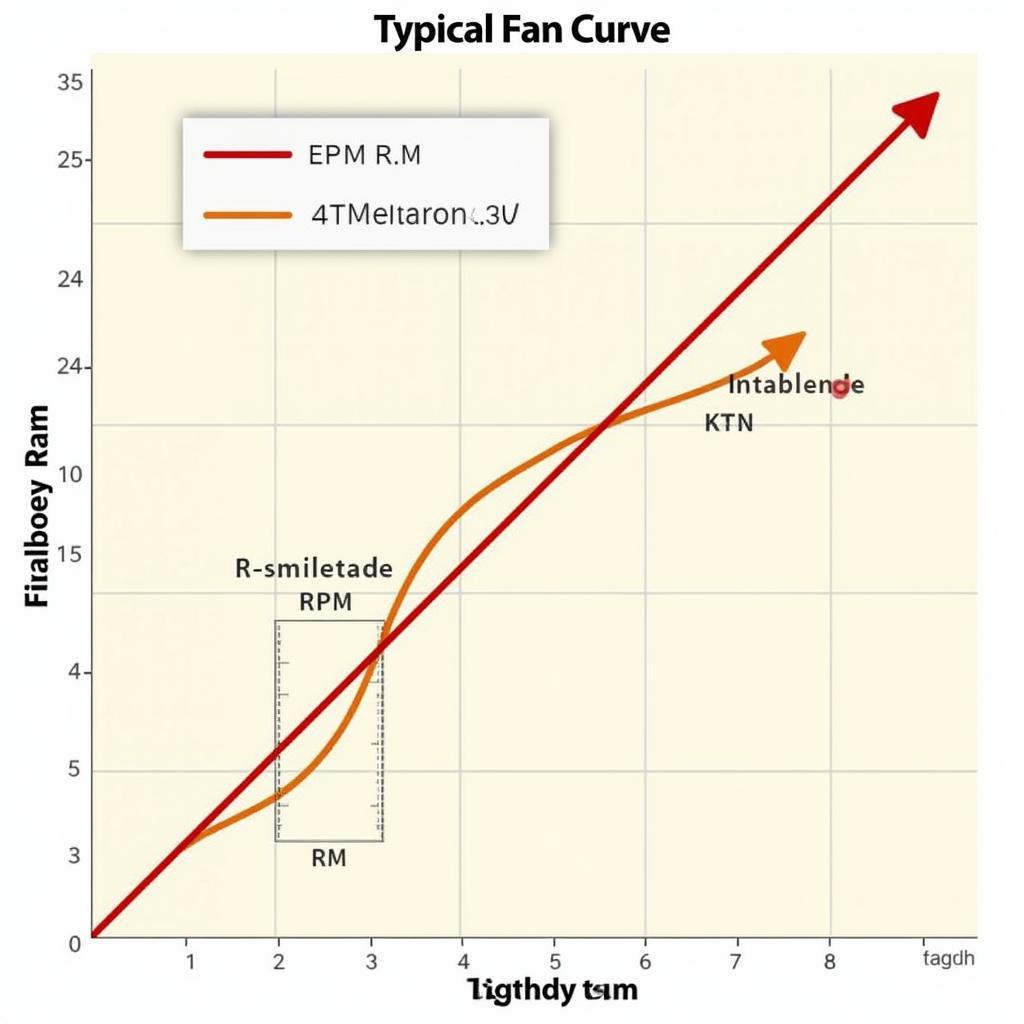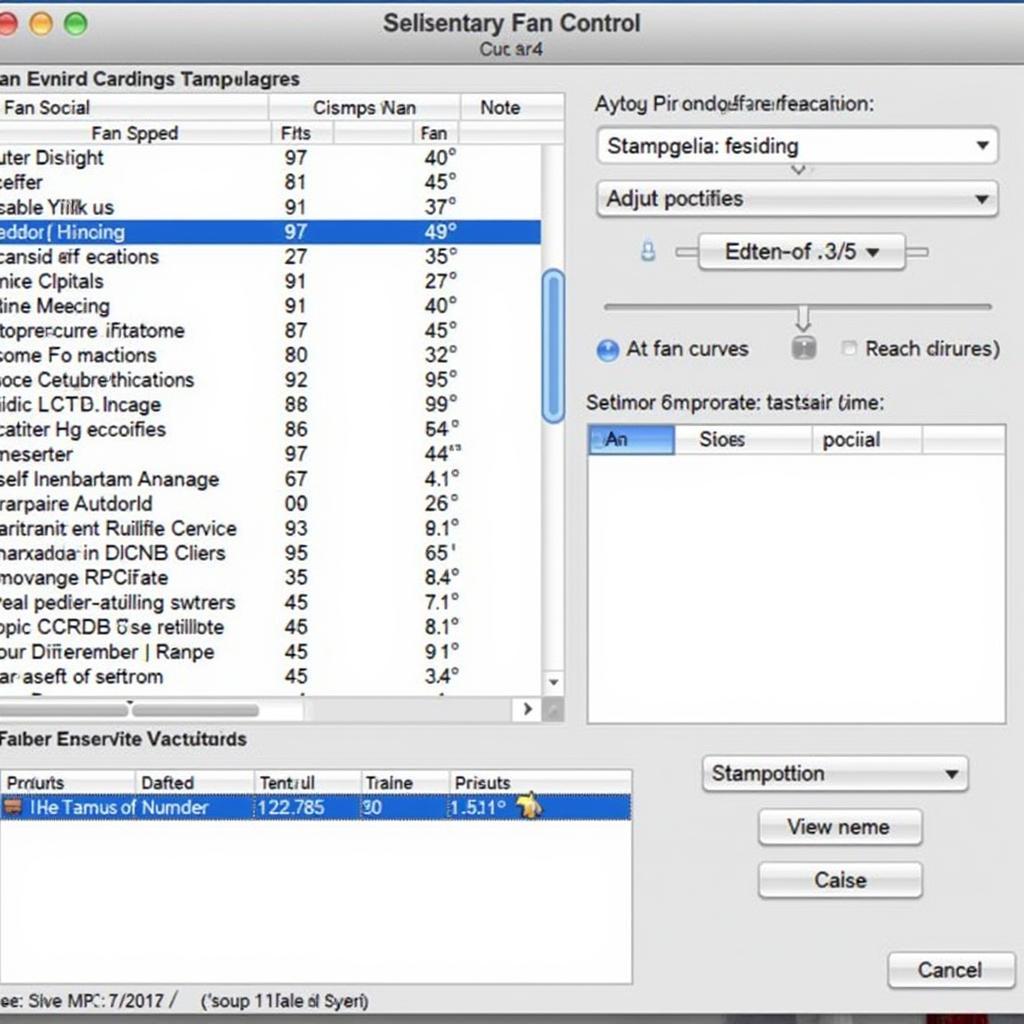Understanding How To Calculate Fan Speed is crucial for maintaining optimal performance and noise levels in various applications, from computer systems to industrial machinery. Whether you’re a tech enthusiast or an HVAC technician, this guide will provide valuable insights into determining the ideal fan speed for your needs.
Factors Affecting Fan Speed
Before diving into calculations, let’s explore the key factors influencing fan speed:
- Airflow Requirements: The primary function of a fan is to move air, and the required airflow varies significantly depending on the application. For instance, a powerful gaming PC demands higher airflow than a simple office computer.
- Cooling Capacity: Fan speed directly impacts cooling efficiency. Higher speeds translate to increased airflow, which dissipates heat more effectively.
- Noise Levels: A trade-off exists between fan speed and noise. While higher speeds enhance cooling, they also generate more noise.
- Fan Size and Design: The physical characteristics of a fan, including blade size, shape, and motor design, influence its speed and airflow capabilities.
Calculating Fan Speed: RPM and CFM
Fan speed is typically measured in revolutions per minute (RPM). However, airflow, measured in cubic feet per minute (CFM), is a more practical metric for determining cooling effectiveness. To calculate fan speed, you need to consider these two factors along with the fan’s specifications.
Understanding Fan Curves
Manufacturers often provide fan curves, which are graphical representations of a fan’s performance characteristics. These curves illustrate the relationship between fan speed (RPM), airflow (CFM), and static pressure.
 Example of a Fan Curve
Example of a Fan Curve
Using Fan Laws for Calculations
Fan laws provide a simplified way to estimate fan performance changes based on speed adjustments. These laws state:
- Airflow is directly proportional to fan speed: Doubling the fan speed roughly doubles the airflow.
- Static pressure is proportional to the square of fan speed: Doubling the speed quadruples the static pressure.
- Power consumption is proportional to the cube of fan speed: Doubling the speed increases power consumption eightfold.
Example:
Let’s say a fan operates at 1000 RPM, delivering 50 CFM. To achieve approximately 100 CFM, you would need to increase the fan speed to 2000 RPM (doubling the speed doubles the airflow). However, remember that this will also significantly increase power consumption and noise levels.
Methods for Adjusting Fan Speed
Several methods exist for controlling fan speed:
- Motherboard Control: Modern motherboards often feature BIOS settings or software utilities to adjust fan speeds based on temperature readings.
- Fan Controllers: Dedicated fan controllers provide more granular control over multiple fans, allowing users to create custom fan curves.
- Voltage Regulation: Lowering the voltage supplied to a fan reduces its speed. However, this method offers limited control and may not be suitable for all fans.
Practical Applications: Finding the Right Balance
The ideal fan speed depends on striking a balance between cooling performance, noise levels, and power consumption.
For PC Enthusiasts:
- Overclocking: Higher fan speeds are essential for dissipating the increased heat generated during overclocking.
- Quiet Computing: Lower fan speeds, particularly during idle periods, minimize noise output for a quieter computing experience.
 Fan Control Software Interface
Fan Control Software Interface
For HVAC Systems:
- Air Conditioning: Fan speed adjustments regulate airflow and temperature distribution in a room or building.
- Ventilation: Higher fan speeds improve air exchange rates, removing stale air and pollutants more effectively.
4 wire fan cpu control arduino allows for precise and automated fan speed control based on temperature readings, optimizing cooling efficiency and noise levels in PC systems.
Conclusion
Calculating fan speed involves understanding the relationship between RPM, CFM, and the factors influencing fan performance. By utilizing fan curves, fan laws, and appropriate speed control methods, you can optimize cooling efficiency, minimize noise, and achieve the desired balance for your specific application.
Expert Insight:
” Finding the optimal fan speed is an iterative process. Start with lower speeds and gradually increase until you achieve the desired cooling performance without excessive noise. Monitoring temperatures is crucial throughout this process.” – John Smith, Senior Cooling Engineer
FAQs
1. Can I damage my fan by running it at maximum speed constantly?
While modern fans are designed to handle maximum speeds for extended periods, continuous operation at full throttle can reduce their lifespan. It’s generally recommended to find a balance between cooling and longevity.
2. How often should I adjust my fan speeds?
The frequency of fan speed adjustments depends on your usage patterns and environmental factors. For PCs, setting up fan curves based on temperature thresholds often provides optimal results.
3. What are PWM fans, and how do they differ from DC fans?
Pulse Width Modulation (PWM) fans offer more precise speed control compared to traditional DC fans. PWM fans receive a constant voltage and use pulses to regulate speed, resulting in greater efficiency and potentially lower noise levels.
4. My fan is making a strange noise. What could be the cause?
Unusual fan noises might indicate dust accumulation, bearing wear, or cable interference. Cleaning, lubrication, or repositioning cables can often resolve these issues.
5. Can I add more fans to my system to improve cooling?
Yes, adding fans can enhance airflow and cooling performance, but it’s crucial to ensure your system provides sufficient power and airflow pathways for optimal results.
Need further assistance? Contact us at 0903426737, email fansbongda@gmail.com, or visit us at Tổ 9, Khu 6, Phường Giếng Đáy, Thành Phố Hạ Long, Giếng Đáy, Hạ Long, Quảng Ninh, Việt Nam. Our dedicated support team is available 24/7 to assist you.


